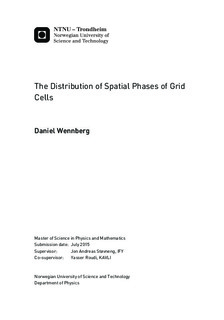The Distribution of Spatial Phases of Grid Cells
Master thesis
Permanent lenke
http://hdl.handle.net/11250/2359808Utgivelsesdato
2015Metadata
Vis full innførselSamlinger
- Institutt for fysikk [2650]
Sammendrag
Grid cells, found in the medial entorhinal cortex of mammalian brains, are among the most significant discoveries from the research into the brain's system for spatial navigation during the last decades. A lot of work has been done to uncover the details of their regular spatial firing pattern and how they operate together in permanent cohort across different environments. In particular, we now know that grid cells are organized in multiple largely independent modules, consisting of cells that respond coherently to new environments and have approximately equal spatial firing patterns, except for a spatial offset known as the \emph{phase}.
A lot of work has also been done on the theoretical front to develop models for how grid cells are part of a network that brings about their characteristic behavior. Some of these models make predictions about the distribution of the phase within a grid cell module. In particular, models based on continuous attractor networks predict that the distribution must be uniform. To evaluate the merit of these and other models, we must therefore develop rigorous methods of analysis to find out what experimental data can tell us about grid phase distribution.
Here, we develop novel ways of analyzing the firing pattern and computing the spatial phase of a grid cell. To analyze the distribution of phases within a module, we employ methods from point process statistics that have not previously been used for this purpose. Our results indicate that there exist grid cell modules with phase distributions that deviate significantly from uniformity.
